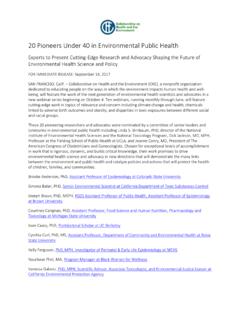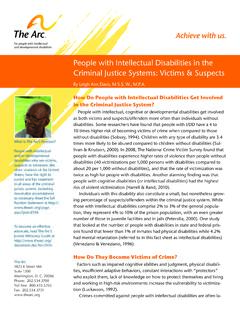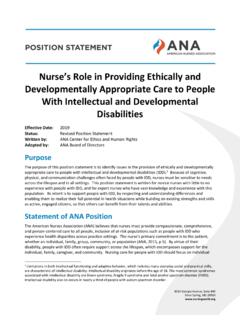Transcription of Learning Disabilities, Behavioral/Emotional Disorders, and ...
1 Learning disabilities , Behavioral/Emotional disorders , and Other Brain disorders : What We Know by Ted Schettler, MD There are many ways that something can go awry in the brain, which can impair our ability to learn, think, move, feel, perceive and/or behave appropriately. A Learning disability is a neurological condition that interferes with a person s ability to store, process, or produce information. There are many types of Learning disabilities . For example, dyslexia (a language-based disability), dyscalculia (a mathematical disability), and dysgraphia (a writing disability) are common Learning disabilities . Learning disabilities affect 5-10% of children in public schools.
2 People with Learning disabilities may have a more difficult time keeping a job or progressing in school. Learning problems that result from mental retardation, emotional disturbance, or visual/hearing impairments are not considered Learning disabilities . The developing brain is extraordinarily sensitive to environmental agents exposure levels that have no lasting effect on an adult s brain can have dramatic effects on the developing brain before birth or during childhood. The brain starts developing early in embryonic life and continues developing into adolescence. Time-lapse images of the brain showing how it matures between ages 5 and 20 and the different amounts of grey matter (blues and purples mean less grey matter, red indicates more grey matter).
3 From Gogtay et al. 2004. Behavioral/Emotional disorders are characterized by: an inability to learn which cannot be explained by intellectual, sensory or health factors an inability to build satisfactory relationship with peers and teachers inappropriate types of behavior or feelings under normal circumstances a general pervasive mood or unhappiness or depression, or a tendency to develop physical symptoms or fear associated with personal or school problems Autism involves life-long difficulties in communication, social interaction, and restrictive or repetitive interests and behaviors. Children with autism or related disorders may not interact and may avoid eye contact.
4 About 2 out of every 1,000 children have autism an estimate much higher than a generation ago. Autism appears to be increasing, although it is not known how much of the increase might be due to better reporting or changes in diagnosis. Autism is much more common amongst boys than girls. Attention disorders such as attention deficit hyperactivity disorder (ADHD) are the most commonly diagnosed behavioral disorders in children, affecting 3-6% of children. Children with ADHD have a persistent pattern of inattention and/or hyperactivity-impulsivity that is more frequent and severe than is typically observed in individuals at a comparable level of development. ADHD and Learning disabilities often occur together.
5 ADHD is much more common in boys than girls, with lower-income boys are at especially high risk . Some studies have demonstrated increases in substance abuse, risk-taking, and criminal behaviors among adolescents and adults with ADHD. Schizophrenia is a serious emotional disorder affecting between and 1% of people. Hallucinations and delusions, disorganized speech, or catatonic behavior are common symptoms, which frequently manifest in young adulthood. The symptoms may also occur in younger children. There are a number of subtypes of schizophrenia. Cerebral palsy, epilepsy, Creutzfeldt-Jakob Disease (CJD), and degenerative illnesses such as Parkinson s disease and Alzheimer s are other conditions where something in the brain has gone awry.
6 What Causes Learning disabilities , emotional / behavioral disorders , and Other Brain disorders ? Genetics, environmental, and social factors interact in complex ways to determine how the brain develops and functions. They may be inherited, or caused by factors that impact brain development before, during, or after birth (such as drugs or poor nutrition before or after birth, German measles before birth, or oxygen deprivation during birth. Or, they can be related to brain trauma or brain tumors. How can environmental agents affect the brain? The brain starts developing early in embryonic life and continues developing into adolescence. The developing brain is extraordinarily sensitive to environmental agents exposure levels that have no lasting effect on an adult s brain can have dramatic effects on the developing brain before birth or during childhood.)
7 One way that environmental agents disrupt brain development is by interfering with the processes that control gene activity. New research is finding, for example, that the compound bisphenol A affects when genes important for controlling brain development are turned on. By altering gene expression, environmental agents can interfere with any one of many steps of brain development, as brain cells divide, differentiate into specialized cell types, establish connections with other brain cells, and die. Environmental agents can also interfere with chemical messengers in the brain that help transmit nerve impulses. Interfering with any one step may impact later steps of brain development.
8 The timing can be as important as the amount of exposure. Thus, even a brief exposure to an environmental agent at an important step in brain development can have significant consequences later in life. Lead, alcohol, and nicotine are known to interfere at several points in brain development. Both lead and alcohol interfere with the differentiation of nerve cells, as well as the transmission of nerve impulses, for example. What role do environmental agents play in Learning disabilities , Behavioral/Emotional disorders , and other brain disorders ? A few chemicals have been studied intensively for their impacts on the brain. However, the vast majority of chemicals to which people are commonly exposed have never been examined at all for their impacts on the developing brain.
9 Among those that have been studied incompletely, evidence coming from a wide array of experiments in the lab point to possible impacts on people. There are many scientific steps between what we understand today and reaching scientific certainty, but we already can make some targeted recommendations about ways that exposure reduction might reduce risks. Below are some examples of environmental agents that affect the brain and can play a role in brain disorders : Lead exposures during infancy and childhood can cause attention problems, hyperactivity, impulsive behavior, reduced IQ, poor school performance, aggression, and delinquent behavior. Lead paint and lead-contaminated water and soil are the major sources of lead exposure to children.
10 The more lead is studied, the more evidence we have showing that levels previously thought safe actually cause harm to the developing brain. Mercury easily crosses the placenta and disrupts many steps in brain development. Even exposures at relatively low levels to a pregnant woman can impair the IQ, language development, visual-spatial skills, memory, and attention of her child. Like with lead, the safe level of mercury keeps dropping the more mercury is studied. Manganese is essential to health at low levels in the diet, but elevated levels of manganese in hair are associated with ADHD, and laboratory experiments in animals link manganese with hyperactivity. It is also associated with Parkinsons.






